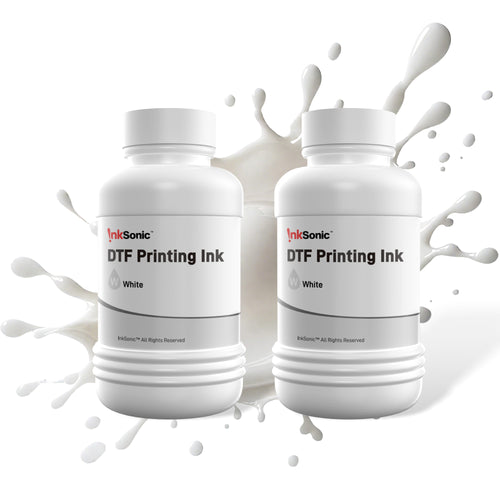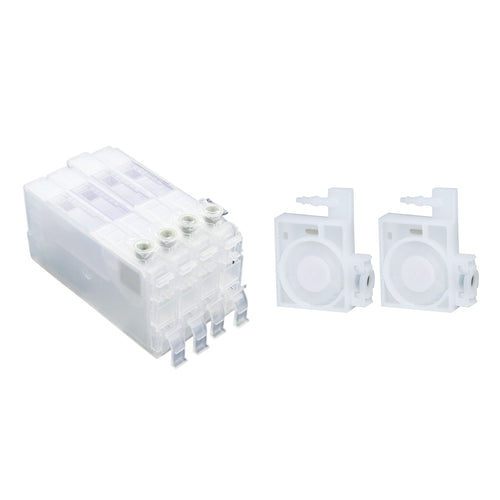1. Introduction
If you're already using a sublimation printer for custom printing, you've probably heard about the rising popularity of DTF (Direct-to-Film) printing. This naturally leads to one big question: Can you use your sublimation printer for DTF printing?
The short answer is: technically yes, but not recommended.
In this article, we'll break everything down quickly and clearly so you know exactly what you're getting into.
2. Quick Overview of Sublimation and DTF

Sublimation
It uses dye-based ink that is made up of very fine particles. In sublimation, the ink adheres directly to the fibers of the substrate. It is generally limited to polyester or polyester-blend substrates (with polyester content generally in excess of 80%). And causes no white color printing, it's best on light-colored backgrounds.
For example:
- Drawing yellow on white paper—there it is in plain sight.
- Dyeing yellow onto black fabric—it's far from effective because the black will pull in the yellow, diminishing color contrast.
DTF Printing
On the other hand, uses pigment ink, which comprises larger particles. It also uses a white underbase layer during printing.
Then, the design is applied on top of the fabric surface once the transfer is done. Therefore, you do not have to worry about fabric color or type.
In case the color appears too light, it can be changed via the printer driver.
3. Overview of the Advantages and Key Considerations
DTF Printing (Direct to Film)
The Advantage of DTF Printing
Item |
Description |
Wide material compatibility |
Works on cotton, blends, denim, dark fabrics, and more |
Supports white ink |
Allows vibrant prints on dark garments |
Vivid color output |
Pigment ink offer brilliant, high-resolution color |
Bright and dimensional colors |
Slightly raised texture after pressing adds a light dimensional feel. |

Something You Need to Focus on DTF Printing
1. Multi-step process
design →printing → powder → bake → heat press – more steps than sublimation(for the first player need time to adapt)
2. Unfamiliar DTF printing Settings
For first-time users, you may need some time to learn the specialized design software for DTF printing. However, InkSonic provides video tutorials and a free support team available 24/7 to help you solve any issues.
3. Requires white ink maintenance
Needs circulation or shaking to avoid clogging and sediment, but actually, for most brands, there is auto white ink circulation to avoid clogged nozzles, like Inksonic
Sublimation Printing
The Advantage of Sublimation Printing
Item |
Description |
Soft and seamless results |
No film feel; colors embed into fibers for a natural finish |
Simple workflow |
Print and press – stable and easy to operate |
Low material cost |
Inexpensive ink and transfer paper – great for mass production |

Something You Need to Focus on: Sublimation Printing
1. Limited fabric choice
Only works on light-colored polyester fabrics or coated substrates; it is not suitable for cotton.
2. No white ink
Can't produce images on dark or black fabrics
3. The printing color weakness
Because the ink particles are too small and there's no white ink to enhance other colors, sublimation printing results often look less vibrant compared to DTF printing.
Tips: And if you want to know more about the difference between sublimation printing and DTF printing, just go to our blog: Sublimation Printing VS DTF Printing
4. Use Sublimation Ink on DTF Film: Is It Worth It?

- The process of trying DTF with sublimation ink sounds simple enough: just swap your sublimation paper for a DTF film, apply the powder, bake, and heat press—exactly like the DTF printing workflow.
- While this "DTF sublimation" method can technically work, once you try it, you’ll quickly realize that the results, especially on dark fabrics, can’t match true DTF printing in vibrancy or durability.
- If your budget allows, InkBear strongly recommends upgrading to a real DTF printing setup. From broader material compatibility to higher-quality results, switching to true DTF is a smart move that can elevate your product line and give your business a fresh new boost.
5. What You Must Know Before Trying This Workaround

- Adhesion Issues: Sublimation ink doesn't react well with the DTF adhesive powder.
- Color Fading: Even if the print initially looks okay, it tends to wash out quickly.
- Clogging Risks: Many sublimation printers aren't designed for film printing — using DTF film may increase the risk of clogs.
6. Final Thoughts
If you’re curious or just want to experiment, it might be fun to try — but if you’re serious about high-quality garment printing, investing in a proper DTF printer setup is the smarter move. You’ll get better results, longer-lasting prints, and access to a broader product range.
Trying to shortcut with sublimation ink on DTF film might seem tempting, but in the long run, it limits your product quality and growth.
FAQ
1. Is a DTF printer expensive?
Entry-level DTF printers are now more affordable, especially desktop models. Prices start around $1,500–$4,000 for different demands.
2. Is DTF printing slow?
Not at all. Many new models offer fast print speeds with automatic powder shaking and film curing.
3. What's the lifespan of a DTF print?
With proper care, DTF prints last 80+ washes, often outlasting traditional heat transfer vinyl or even sublimation on light polyester.
4. Is DTF printing hard to learn?
With the right machine and tutorial support, even beginners can master it within days.
5. What’s the real DTF printing cost per print?
Usually $0.50 to $1.00 for a full front design, including film, ink, and powder — highly cost-effective for custom tees.
6. Is the Sublimation printer used with DTF ink?
Not recommended, because DTF ink typically has larger pigment particles compared to sublimation ink, which makes it more likely to clog the printer's pipelines. Additionally, sublimation printers do not have a white ink channel, so they cannot achieve the same results as a true DTF printer.
In short: if you're serious about fabric printing beyond polyester and want to grow your custom merch business, skip the hacks — get a real DTF printer.


































